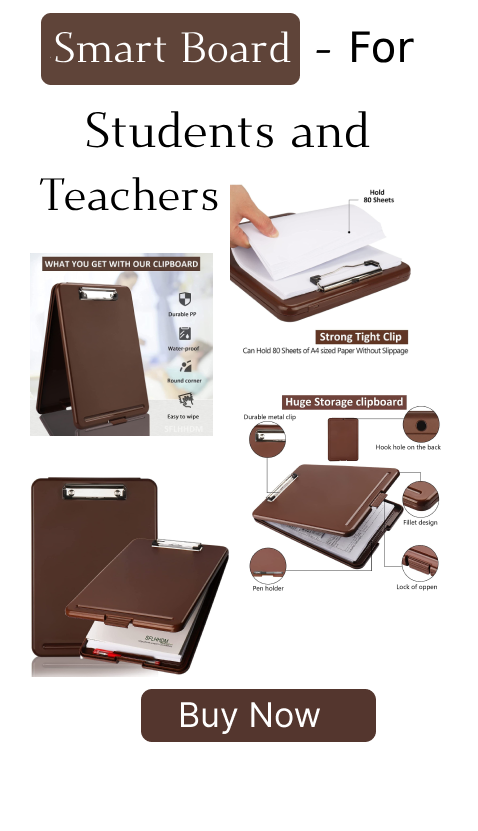Ex 12.2 class 12 maths ncert solutions | class 12 maths exercise 12.2 | class 12 maths ncert solutions chapter 12 exercise 12.2 | exercise 12.2 class 12 maths ncert solutions | class 12 maths chapter 12 ncert solutions | class 12 chapter 12 maths ncert solutions | ncert solutions for class 12 maths ch 12 | ncert solutions for class 12 maths chapter 12 | linear programming class 12 ncert solutions
Want to master Linear Programming with complete clarity? The Class 12 Maths NCERT Solutions Chapter 12 Exercise 12.2 is a powerful resource designed to help you solve linear optimization problems involving real-world constraints. Whether you’re looking for Class 12 Maths Exercise 12.2, Exercise 12.2 Class 12 Maths NCERT Solutions, or the complete NCERT Solutions for Class 12 Maths Chapter 12, this guide breaks down every question using clear graphical methods. With the help of these Linear Programming Class 12 NCERT Solutions, you can confidently tackle questions on feasible regions, optimal solutions, and inequality constraints—all in line with the latest CBSE syllabus.
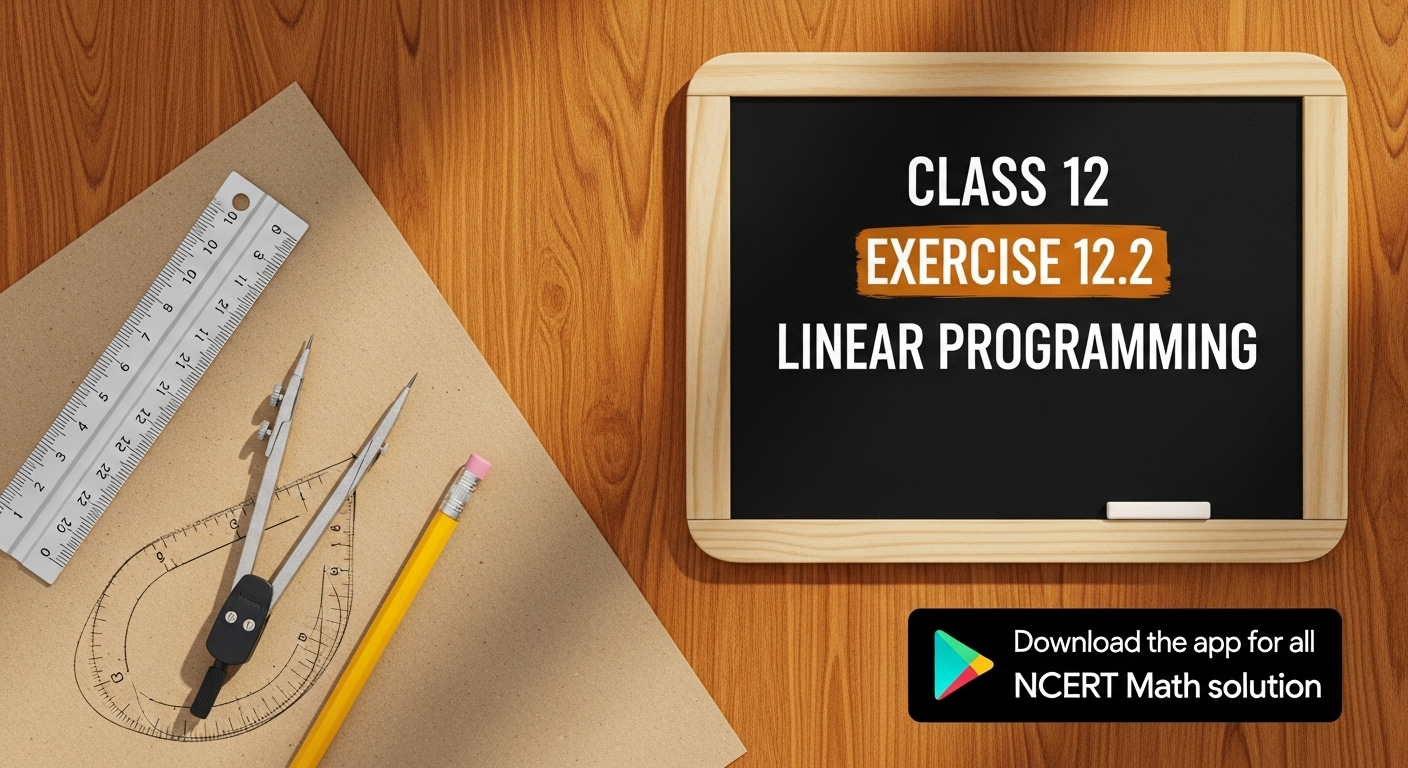
ncert solutions for class 12 maths ch 12 || class 12 maths exercise 12.2 || class 12 chapter 12 maths ncert solutions || ex 12.2 class 12 maths ncert solutions || exercise 12.2 class 12 maths ncert solutions || linear programming class 12 ncert solutions || class 12 maths chapter 12 ncert solutions || ncert solutions for class 12 maths chapter 12 || class 12 maths ncert solutions chapter 12 exercise 12.2
Exercise 12.2
1. Reshma wishes to mix two types of food P and Q in such a way that the vitamin contents of the mixture contain at least 8 units of vitamin A and 11 units of vitamin B. Food P costs Rs \( 60 / \mathrm{kg} \) and Food Q costs Rs \( 80 / \mathrm{kg} \). Food P contains 3 units \( / \mathrm{kg} \) of Vitamin A and 5 units \( / \mathrm{kg} \) of Vitamin B while food Q contains 4 units \( / \mathrm{kg} \) of Vitamin A and 2 units \( / \mathrm{kg} \) of vitamin B. Determine the minimum cost of the mixture.
Answer
Let the mixture consists of \(x\) kg of food P and \(y\) kg of food \( \mathrm{Q} . \therefore x \geq 0 \) and \( y \geq 0 \)
According to given situation in the question, the information can be tabulated as follows:
\(\begin{array}{|l|l|l|l|}
\hline & \begin{array}{l}
\text{Vitamin A} \\
\text{(units /kg)}
\end{array} & \begin{array}{l}
\text{Vitamin B} \\
\text{(units/kg)}
\end{array} & \begin{array}{l}
\text{Cost} \\
\text{(Rs/kg)}
\end{array} \\
\hline \text{Food P} & 3 & 4 & 60 \\
\hline \text{Food Q} & 5 & 2 & 80 \\
\hline \begin{array}{l}
\text{Requirements} \\
\text{(units/kg)}
\end{array} & 8 & 11 & \\
\hline
\end{array}\)
The mixture must contain at least 8 units of vitamin A and 11 units of vitamin B.
\( \therefore \) The constraints are:
\(\begin{array}{l}
3 x+4 y \geq 8 \text { and } \\
5 x+2 y \geq 11
\end{array}\)
Where \( x \geq 0 \) and \( y \geq 0 \)
Total cost of ' \( Z \) ' of purchasing food is \( Z=60 x+80 y \)
The mathematical formulation of the given problem is: minimize \( z=60 x \) \( +80 y \ldots \ldots .1 \)
Subject to constraints
\( 3 x+4 y \geq 8 \) and
\( 5 x+2 y \geq 11 \)
Where \( x, y \geq 0 \)
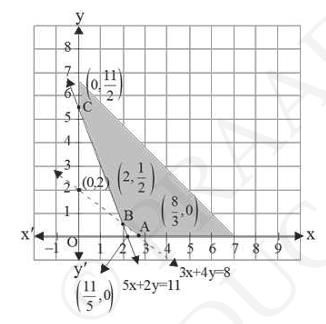
The graphical representation shows the feasible region is unbounded.
The corner points of the feasible region are \( \mathrm{A}\left(\frac{8}{3}, 0\right), \mathrm{B}\left(2, \frac{1}{2}\right) \) and \( \mathrm{C}\left(0, \frac{11}{2}\right) \)
The values of Z at these corner points are
\(\begin{array}{|l|l|l|}
\hline Corner\ points & \mathbf{Z}= 6 0 x + 8 0 y & \\
\hline A \left(\frac{8}{3}, 0\right) & 160 & \text{minimum} \\
\hline B \left(2, \frac{1}{2}\right) & 160 & \text{minimum} \\
\hline C \left(0, \frac{11}{2}\right) & 440 & \\
\hline
\end{array} \)
As the feasible region is unbounded
\( \therefore 160 \) may or may not be the minimum value of \( Z \)
But it can be seen that the feasible region has no common point with \( 3 x+4 y \) \( < 8 \)
So the minimum cost of the mixture will be Rs\(160\) at the line segment joining the points \( \mathrm{A}\left(\frac{8}{3}, 0\right) \) AND \( \mathrm{b}\left(2, \frac{1}{2}\right) \)
2. One kind of cake requires 200 g of flour and 25 g of fat, and another kind of cake requires 100 g of flour and 50 g of fat. Find the maximum number of cakes which can be made from 5 kg of flour and 1 kg of fat assuming that there is no shortage of the other ingredients used in making the cakes.
Answer
let there be \( x\) cakes of first kind and \(y\) cakes of second kind.
\( \therefore x \geq 0 \) and \( y \geq 0 \).
The information given in the question can be complied in given form
\(\begin{array}{|l|l|l|}
\hline & \text{Flour} & \text{Fat} \\
\hline \text{Cake of first kind, \(x\) } & 200 & 25 \\
\hline \text{Cake of Second kind, \(y\)} & 100 & 50 \\
\hline \text{Avaibility} & 5000 & 1000 \\
\hline
\end{array}\)
\( 200 x+100 y \leq 5000 \Rightarrow 2 x+y \leq 50 \)
\( \& \ 25 x+50 y \leq 1000 \Rightarrow x+2 y \leq 40 \)
Let Z be the total number of cakes that can be made
\(\Rightarrow z=x=y\)
Mathematical formulation of the given problem is
Maximize \( z=x+y \)
Subject to constraint \( 2 x+y \leq 50 \) and \( x+2 y \leq 40 \) where \( x, y \geq 0 \)
The graphical representation shows the feasible region determined by the system of constraints.
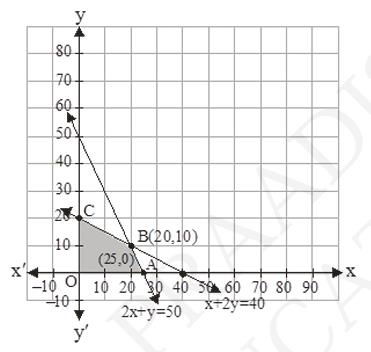
The corner points \( \mathrm{A}(25,0), \mathrm{B}(20,10), 0(0,0) \) and \(\mathrm{C}(0,20)\)
The values of \( z \) at these corner points are as follows
\(\begin{array}{|l|l|l|}
\hline \text{Corner point} & Z=x+y & \\
\hline A (25,0) & 25 & \\
\hline B (20,10) & 30 & \text{maximum} \\
\hline 0(0,0) & 20 & \\
\hline \mathrm{C}(0,20) & 0 & \\
\hline
\end{array}\)
Thus, the maximum number of cakes that can be made are 30 ( 20 of one kind and 10 of other kind)
3. A factory makes tennis rackets and cricket bats. A tennis racket takes 1.5 hours of machine time and 3 hours of craftman's time in its making while a cricket bat takes 3 hour of machine time and 1 hour of craftman's time. In a day, the factory has the availability of not more than 42 hours of machine time and 24 hours of craftsman's time.
(i) What number of rackets and bats must be made if the factory is to work at full capacity?
(ii) If the profit on a racket and on a bat is Rs 20 and Rs 10 respectively, find the maximum profit of the factory when it works at full capacity.
(i) What number of rackets and bats must be made if the factory is to work at full capacity?
(ii) If the profit on a racket and on a bat is Rs 20 and Rs 10 respectively, find the maximum profit of the factory when it works at full capacity.
Answer
Let the number of rackets and the number of bats to be made be \(x\) and \(y\) respectively.
The machine time available is not more than 42 hours.
\(\therefore 1.5 x+3 y \leq 42\)
The craftsman`s time is not available for more than 24 hours
\(\therefore 3 x+y \leq 24\)
The factory is to work at full capacity
\(\therefore 1.5 x+3 y=42\)
\(3 x+y=24\)
Where \( x \) and \( y \geq 0 \)
Solving the two equations we get \( x=4 \) and \( y=12 \)
Thus 4 rackets and 12 bats must be made
(i) The given information can be complied in the tables form as follows
\(\begin{array}{|c|c|c|c|}
\hline & \text{Tennis racket} & \text{Cricket bat} & \text{Availability} \\
\hline \begin{array}{l}
\text{Machine time} \\
\text{(h)}
\end{array} & 1.5 & 3 & 42 \\
\hline \begin{array}{l}
\begin{array}{l}
\text{Craft's man} \\
\text{time (h)}
\end{array}
\end{array} & 3 & 1 & 24 \\
\hline
\end{array}\)
The profit on a racket is Rs 20 and on bat is Rs 10
Maximize, \( Z=20 x+10 y \ldots (1) \)
Subject to constraints
\(1.5 x+3 y=42\)
\(3 x+y=24\)
\(x, y \geq 0\)
the feasible region determined by the system of constraints is:
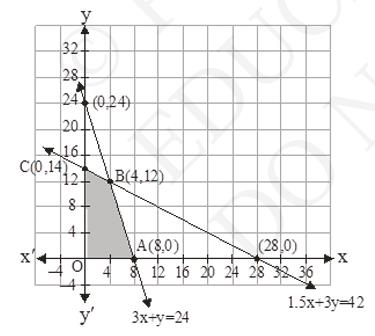
The corner points are \( \mathrm{A}(8,0), \mathrm{B}(4,12), \mathrm{C}(0,14) \) and \( \mathrm{O}(0,0) \)
The values of Z at these corner points are as follows:
\(\begin{array}{|l|l|l|}
\hline \text{Corner point} & Z=20 x+10 y & \\
\hline A(8,0) & 160 & \\
\hline \mathrm{B}(4,120) & 200 & \text{maximum} \\
\hline \mathrm{C}(0,14) & 140 & \\
\hline \mathrm{O}(0,0) & 0 & \\
\hline
\end{array}\)
Thus the maximum profit of the factory is when it works to its full capacity is Rs 200 .
4. A manufacturer produces nuts and bolts. It takes 1 hour of work on machine \( A \) and 3 hours on machine \( B \) to produce a package of nuts. It takes 3 hours on machine \(A\) and 1 hour on machine \(B\) to produce a package of bolts. He earns a profit of Rs 17.50 per package on nuts and Rs 7.00 per package on bolts. How many packages of each should be produced each day so as to maximise his profit, if he operates his machines for at the most 12 hours a day?
Answer
let the number of packages of nuts produce be \(x\)
Let the number of bolts produced be \(y\)
The tabular representation of data given is as follows:
\(\begin{array}{|l|l|l|l|l|}
\hline \text{item} & \text{Number} & \text{Machine A} & \text{Machine B} & \text{Profit}\\
\hline \text{Nuts} & \text{X} & 1 \text{hr} & 3 \text{hr} & 17.50 \\
\hline \text{Bolts} & \text{Y} & 3 \text{hr} & 1 \text{hr} & 7.00 \\
\hline \begin{array}{l}
\text{Maximum} \\
\text{Time} \\
\text{available}\\
\end{array} & & 12 \text{hr} & 12 \text{hr} & \\
\hline
\end{array}\)
The system of constraints is given as
\(x+3 y \leq 12\)
\( \&\ 3 y+x \leq 12 \)
Where \( x \) and \( y \geq 0 \)
We need to maximize the profit, so the function here will be maximizing Z
Maximize \( z=17.5 x+7.5 y \)
Subject to constraints
\(x+3 y \leq 12\)
\( \&\ 3 y+x \leq 12 \)
Where \( x \) and \( y \geq 0 \)
The corner points are \( \mathrm{A}(4,0), \mathrm{B}(3,3), \mathrm{C}(0,4) \) and \( \mathrm{O}(12,0) \)
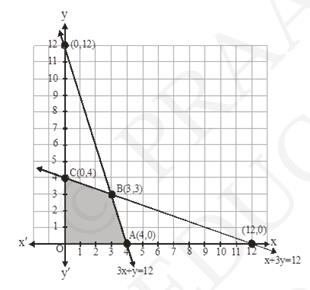
\(\begin{array}{|l|l|}
\hline \mathrm{A}(4,0) & 70 \\
\hline \mathrm{B}(3,3) & 73.5 \ \text{maximum} \\
\hline \mathrm{C}(0,40) & 28 \\
\hline \mathrm{O}(0,0) & 0 \\
\hline
\end{array} \)
Hence the profit will be maximum if the company produces
Number of bolts -3 packages
Number of nuts -3 packages
Maximum profit is Rs 73.50
ncert solutions for class 12 maths ch 12 || class 12 maths exercise 12.2 || class 12 chapter 12 maths ncert solutions || ex 12.2 class 12 maths ncert solutions || exercise 12.2 class 12 maths ncert solutions || linear programming class 12 ncert solutions || class 12 maths chapter 12 ncert solutions || ncert solutions for class 12 maths chapter 12 || class 12 maths ncert solutions chapter 12 exercise 12.2
5. \(A\) factory manufactures two types of screws, \(A\) and \(B\). Each type of screw requires the use of two machines, an automatic and a hand operated. It takes 4 minutes on the automatic and 6 minutes on hand operated machines to manufacture a package of screws \(A\) , while it takes 6 minutes on automatic and 3 minutes on the hand operated machines to manufacture a package of screws \(B\). Each machine is available for at the most 4 hours on any day. The manufacturer can sell a package of screws \(A\) at a profit of Rs 7 and screws \(B\) at a profit of Rs 10 . Assuming that he can sell all the screws he manufactures, how many packages of each type should the factory owner produce in a day in order to maximise his profit? Determine the maximum profit.
Answer
Let the factory manufacture \(x\) screws of type \(A\) and \(y\) screws of type \(B\) on each day.
\( \therefore x \) and \( y \geq 0 \)
The tabular form of the given data in the question is
\(\begin{array}{|l|l|l|l|}
\hline & \text{Screw A} & \text{Screw B} & \text{Availability} \\
\hline \begin{array}{l}
\text{Automatic} \\
\text{Machine (min)}
\end{array} & 4 & 6 & 4 \times 60=240 \\
\hline \begin{array}{l}
\text{Hand operated} \\
\text{machines (min)}
\end{array} & 6 & 3 & 4 \times 60=240 \\
\hline
\end{array} \)
The profit on a package of screws \(A\) is Rs 7 and on package of screws \(B\) is Rs 10 .
\( \therefore \) the constraints are
\( 4 x+6 y \leq 240 \)
And \( 6 x+3 y \leq 240 \) and \( x, y \geq 0 \)
And total profit is \( z=7 x+10 y \)
The mathematical formulation of the data is
Maximizing \( z=7 x+10 y \)
Subject to constraints
\( 4 x+6 y \leq 240 \)
And \( 6 x+3 y \leq 240 \) and \( x, y \geq 0 \)
The feasible reason is determined by the system of constraints is:
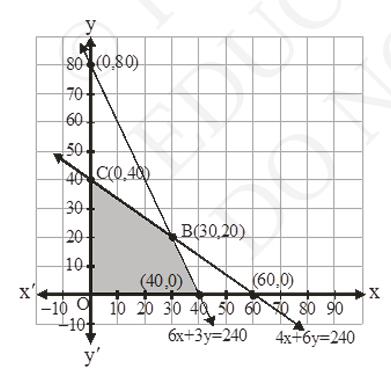
The corner points are \( \mathrm{A}(40,0), \mathrm{B}(30,20), \mathrm{C}(0,40) \)
The value of \( Z \) at these points is
\(\begin{array}{|l|l|l|}
\hline \text{Corner point} & Z=7 z+1 0 y & \\
\hline \text{A} (40,0) & 280 & \\
\hline \text{B} (30,20) & 410 & \text{Maximum} \\
\hline \text{C} (0,40) & 400 & \\
\hline
\end{array}\)
The maximum value of \( Z \) is at point \( B(30,20) \)
Therefore factory should produce 30 packages of screw \(A\) and 20 packages of screw \(B\) to get the maximum profit of Rs 410 .
6. A cottage industry manufactures pedestal lamps and wooden shades, each requiring the use of a grinding/cutting machine and a sprayer. It takes 2 hours on grinding/cutting machine and 3 hours on the sprayer to manufacture a pedestal lamp. It takes 1 hour on the grinding/cutting machine and 2 hours on the sprayer to manufacture a shade. On any day, the sprayer is available for at the most 20 hours and the grinding/cutting machine for at the most 12 hours. The profit from the sale of a lamp is Rs 5 and that from a shade is Rs 3 . Assuming that the manufacturer can sell all the lamps and shades that he produces, how should he schedule his daily production in order to maximise his profit?
Answer
let the cottage industry manufacture \(x\) number of pedestal lamps and \(y\) number of wooden shades.
\( \therefore x \) and \( y \geq 0 \)
The given information can be represented in the following tabular form:
\(\begin{array}{|l|l|l|l|}
\hline & \text{Lamps} & \text{Shades} & \text{Availability} \\
\hline \begin{array}{l}
\text{Grinding/cutting} \\
\text{machine (hr)}
\end{array} & 2 & 1 & 12 \\
\hline \text{Sprayer (hr)} & 3 & 2 & 30 \\
\hline
\end{array}\)
The profit on lamps is Rs 5 and that on the shades is Rs 3 .
\( \therefore \) The constraints are \( 2 x+y \leq 12 \)
And \( 3 x+2 y \leq 20 \)
\(x, y \geq 0\)
Total profit, \( z=5 x+3 y \)
The mathematical formulation of the given problem is
Maximize \( Z=5 x+3 y \)
Subject to constraints
\(2 x+y \leq 12\)
And \( 3 x+2 y \leq 20 \)
\(x, y \geq 0\)
the feasible region determined by the system of constraints can be represented graphically as
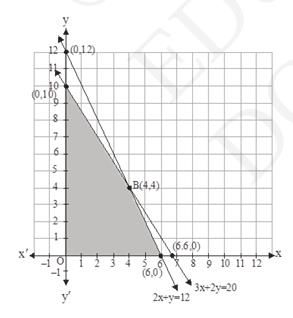
The corner points are \( \mathrm{A}(6,0), \mathrm{B}(4,4) \) and \( \mathrm{C}(0,10) \)
The value of Z at the corner points are as follows
\(\begin{array}{|l|l|l|}
\hline \text{Corner point} & Z=5 x+3 y & \\
\hline \mathrm{A}(6,0) & 30 & \\
\hline \mathrm{B}(4,4) & 32 & \text{maximum} \\
\hline \mathrm{C}(0,10) & 30 & \\
\hline
\end{array}\)
The maximum value of \( Z \) is 32 at \( B(4,4) \)
Thus the manufacturer should produce 4 pedestal lamps and 4 wooden shades to maximize his profits of Rs 32 .
7. A company manufactures two types of novelty souvenirs made of plywood. Souvenirs of type \(A\) require 5 minutes each for cutting and 10 minutes each for assembling. Souvenirs of type \(B\) require 8 minutes each for cutting and 8 minutes each for assembling. There are 3 hours 20 minutes available for cutting and 4 hours for assembling. The profit is Rs 5 each for type \(A\) and Rs 6 each for type \(B\) souvenirs. How many souvenirs of each type should the company manufacture in order to maximize the profit?
Answer
Let the company manufacturer \( x \) souvenirs of type \(A\) and \(y\) souvenirs of type \(B\)
\( \therefore x \) and \( y \geq 0 \)
The tabular representation of the given data is:
\(\begin{array}{|l|l|l|l|}
\hline & \text{Type A} & \text{Type B} & \text{Availability} \\
\hline \text{Cutting ( min)} & 5 & 8 & 3 \times 60+20=200 \\
\hline \text{Manufacturing} (\mathrm{min}) & 10 & 8 & 4 \times 60=240 \\
\hline
\end{array}\)
The profit on type \(A\) souvenirs is Rs 5 and that on type \(B\) souvenirs is Rs 6 .
The constraints here are of the form:
\(5 x+8 y \leq 200\)
And \( 10 x+8 y \leq 240 \) or \( 5 x+4 y \leq 120 \)
The function is to maximize the profit \( Z=5 x+6 y \)
The mathematical formulation of the data
Maximise \( Z=5 x+6 y \)
Subject to constraints
\(5 x+8 y \leq 200\)
\(5 x+4 y \leq 120\)
\( x \) and \( y \geq 0 \)
The feasible region is determined by the system of constraints is as follows:
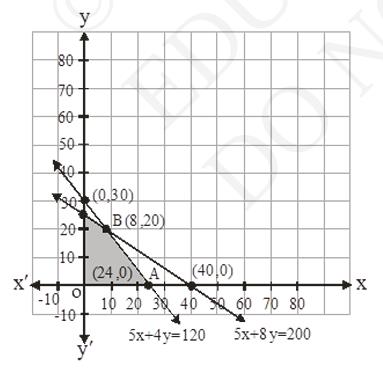
The corner points here are \( \mathrm{A}(24,0), \mathrm{B}(8,20) \) and \( \mathrm{C}(0,25) \)
The value of Z at these corner points are :
\(\begin{array}{|l|l|l|}
\hline \text{Corner points} & Z=5 x+6 y & \\
\hline \mathrm{A}(24,0) & 120 & \\
\hline \mathrm{B}(8,20) & 160 & \text{Maximum} \\
\hline \mathrm{C}(0,25) & 150 & \\
\hline
\end{array}\)
The maximum value of Z is at the point \( (8,20) \)
Thus the firm should produce 8 number of souvenirs of type \(A\) and 20 type \(B\) souvenirs each day in order to maximize its profit of Rs 160.
8. A merchant plans to sell two types of personal computers - a desktop model and a portable model that will cost Rs 25000 and Rs 40000 respectively. He estimates that the total monthly demand of computers will not exceed 250 units. Determine the number of units of each type of computers which the merchant should stock to get maximum profit if he does not want to invest more than Rs 70 lakhs and if his profit on the desktop model is Rs 4500 and on portable model is Rs 5000 .
Answer
Let the merchant stock \(x\) number of desktop models and \(y\) number of portable models.
\( \therefore x \) and \( y \geq 0 \)
According to the given condition
The cost of a desKtop model is Rs 25000 and that of a portable model is Rs 40,000 . The merchant can invest up to Rs 7000000
\(\Rightarrow 25000 x+40000 y \leq 7000000\)
\(\Rightarrow 5 x+8 y \leq 1400\)
The monthly demand of computers will not exceed 250 units.
\(\Rightarrow x+y \leq 250\)
The profit on a desktop model is Rs 4500 and the profit on a portable model is Rs 5000.
Total profit, \( Z=4500 x+5000 y \)
Thus the mathematical formulation of the data is
Maximize \( Z=4500 x+5000 y \)
Subject to constraints
\(5 x+8 y \leq 1400\)
\(x+y \leq 250\)
\(x \text { and } y \geq 0\)
the feasible region by the system of constraints is as follows:
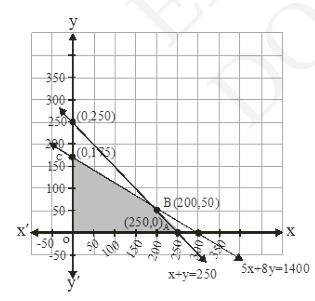
The cornet points are \( \mathrm{A}(250,0), \mathrm{B}(200,50) \) and \( \mathrm{C}(0,175) \)
The value of \( Z \) at the given corners points are:
\(\begin{array}{|l|l|l|}
\hline \text{Corner point} & Z=4500 + 5000 y & \\
\hline A (250,0) & 1125000 & \\
\hline B (200,50) & 1150000 & \text{maximum} \\
\hline \mathrm{C}(0,1750) & 875000 & \\
\hline
\end{array}\)
The maximum value of Z is Rs 1150000 at \( (200,50) \)
Thus the merchant should stock 200 desktop models and 50 portable models to earn the maximum profit of Rs \( 11,50,000 \).
9. A diet is to contain at least 80 units of vitamin A and 100 units of minerals. Two foods \( F_{1} \) and \( F_{2} \) are available. Food \( F_{1} \) costs Rs 4 per unit food and \( F_{2} \) costs Rs 6 per unit. One unit of food \( F_{1} \) contains 3 units of vitamin \( A \) and 4 units of minerals. One unit of food \( F_{2} \) contains 6 units of vitamin \( A \) and 3 units of minerals. Formulate this as a linear programming problem. Find the minimum cost for diet that consists of mixture of these two foods and also meets the minimal nutritional requirements.
Answer
let the diet contain \( x \) units of food \( F_{1} \) and \( y \) units of food \( F_{2} \).
\( \therefore x \) and \( y \geq 0 \)
The tabular representation of the data is
\(\begin{array}{|l|l|l|ll|}
\hline & \begin{array}{l}
\text{Vitamin A} \\
\text{(units)}
\end{array} & \text{Minerals} & \begin{array}{l}
\text{Cost per unit} \\
(\mathrm{Rs})
\end{array} \\
\hline \text{food} \ F_{1} & 3 & 4 & 4 & \\
\hline \text{food} \ F_{2} & 6 & 3 & 6 & \\
\hline \text{Requirement} & 80 & 100 & & \\
\hline
\end{array}\)
The cost of food \( F_{1} \) is Rs 4 / unit and the cost of food \( F_{2} \) is Rs 6 per unit.
The constraints here are
\(\begin{array}{l}
3 x+6 y \geq 80 \\
4 x+3 y \geq 100 \\
x \text { and } y \geq 0
\end{array}\)
Total cost of the diet \( Z=4 x+6 y \)
The mathematical formulation of the given data is maximize \( Z=4 x+6 y \)
Subject to constraints
\(3 x+6 y \geq 80\)
\(4 x+3 y \geq 100\)
\(x \text { and } y \geq 0\)
the feasible region by the system of constraints is as follows:
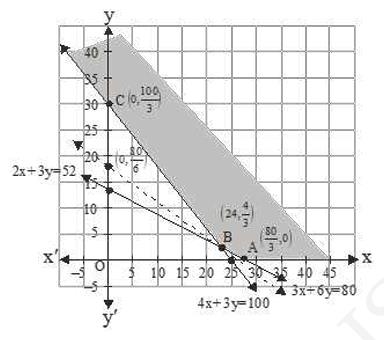
It can be seen the feasible region is unbounded with
The corner points of the feasible region are A \( \left(\frac{80}{3}, 0\right), B\left(24, \frac{4}{3}\right), C\left(0, \frac{100}{3}\right) \)
The values of \( Z \) at the corner points are
\(\begin{array}{|l|l|l|}
\hline \text{Corner points} & Z=4 x+6 y & \\
\hline \mathrm{A}\left(\frac{80}{3}, 0\right) & 106.67 & \\
\hline \mathrm{B}\left(24, \frac{4}{3}\right) & 104 & \text{minimum} \\
\hline \mathrm{C}\left(0, \frac{100}{3}\right) & 200 & \\
\hline
\end{array}\)
As the feasible region is unbounded therefore 104 may or may not be the minimum value of \( Z \).
For this we will draw a graph of inequality \( 4 x+6 y < 104 \)
It can be seen that the feasible region has no common points with \( 4 x+ \) \( 6 y < 104 \)
\( \therefore \) the maximum cost of the mixture will be Rs 104.
10. There are two types of fertilisers \( F_{1} \) and \( F_{2} \). \( F_{1} \) consists of \( 10 \% \) nitrogen and \( 6 \% \) phosphoric acid and \( \mathrm{F}_{2} \) consists of \( 5 \% \) nitrogen and \( 10 \% \) phosphoric acid. After testing the soil conditions, a farmer finds that she needs at least 14 kg of nitrogen and 14 kg of phosphoric acid for her crop. If \( F_{1} \) costs Rs \( 6 / \mathrm{kg} \) and \( F_{2} \) costs Rs \( 5 / \mathrm{kg} \), determine how much of each type of fertiliser should be used so that nutrient requirements are met at a minimum cost. What is the minimum cost?
Answer
Let the farmer buy \(x\) kf of fertilizer \( f_{1} \) and \( y \mathrm{~kg} \) of fertilizer \( f_{2} \)
\( \therefore x \) and \( y \geq 0 \)
The tabular representation of the data is as follows:
\(\begin{array}{|l|l|l|l|}
\hline & \text{Nitrogen(%)} & \begin{array}{l}
\text{phosphoric} \\
\text{Acid (%)}
\end{array} & \text{Cost (Rs/kg)} \\
\hline F_{1}(x) & 10 & 6 & 6 \\
\hline F_{2}(y) & 5 & 10 & 5 \\
\hline \begin{array}{l}
\text{Requirement} \\
(\mathrm{kg})
\end{array} & 14 & 14 & \\
\hline
\end{array}\)
\( \mathrm{F}_{1} \) consists of \( 10 \% \) nitrogen and \( \mathrm{F}_{2} \) consists of \( 5 \% \) nitrogen. But the farmer requires at least 14 kg of nitrogen.
\(10 \% \times x+5 \% \times y \geq 14\)
\(\frac{x}{10}+\frac{y}{20} \geq 14\)
\(\Rightarrow 2 x+y \geq 280\)
food \( F_{1} \) consists of \( 6 \% \) phosphoric acid and food \( F_{2} \) consists of \( 10 \% \) phosphoric acid. But the farmer requires at least 14 kg of phosphoric acid
\(\Rightarrow 6 \% \times x+10 \% \text { of } y \geq 14\)
\(\Rightarrow \frac{6 x}{100}+\frac{10 y}{100} \geq 14\)
\(\Rightarrow 3 x+56 y \geq 700\)
Total cost of fertilizers, \( z=6 x+5 y \)
The mathematical formulation of the given data is
Minimize, \( Z=6 x+5 y \)
Subject to constraints
\(2 x+y \geq 280\)
\(3 x+56 y \geq 700\)
\(x \text { and } y \geq 0\)
The feasible region determined by the system of constraint is:
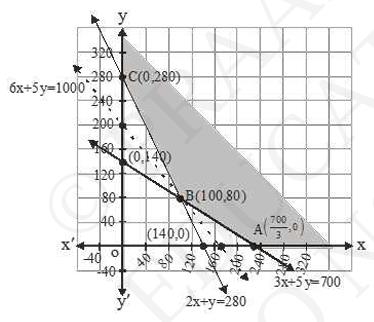
It can be seen from the graph that the feasible region is unbounded
The corner points are \( \mathrm{A}\left(\frac{700}{3}, 0\right) B(100,80) \) and \( C(0,280) \)
The value of Z at these points are:
\(\begin{array}{|l|l|l|}
\hline \text{Corner points} & z=6 x+5 y & \\
\hline \mathrm{A}\left(\frac{700}{3}, 0\right) & 1400 & \\
\hline \mathrm{B}(100,80) & 100 & \text{Minimum} \\
\hline \mathrm{C}(0,280) & 1400 & \\
\hline
\end{array}\)
As the feasible region is unbounded, 1000 may or may not be the minimum value
For this we will draw graph of inequality
\(6 x+5 y < 1000\)
It can be seen there is no common point between feasible region and \( 6 x+ \) \( 5 y < 1000 \)
\( \therefore 100 \ \mathrm{KG} \) of fertilizer \( \mathrm{F}_{1} \) and 80 kg of fertilizer \( \mathrm{F}_{2} \) should be used to minimize the cost and the minimum cost is Rs 1000 .
11. The corner points of the feasible region determined by the following system of linear inequalities:
\( 2 x+y \leq 10, x+3 y \leq 15, x, y \geq 0 \) are \( (0,0),(5,0),(3,4) \) and \( (0,5) \). Let
\( z=\mathrm{px}+\mathrm{qy} \), where \( \mathrm{p}, \mathrm{q} > 0 \). Condition on p and q so that the maximum of \( Z \) occurs at both \( (3,4) \) and \( (0,5) \) is
A. \( p=q \) B. \( p=2 q \) C. \( p=3 q \) D. \( q=3 p \)
\( 2 x+y \leq 10, x+3 y \leq 15, x, y \geq 0 \) are \( (0,0),(5,0),(3,4) \) and \( (0,5) \). Let
\( z=\mathrm{px}+\mathrm{qy} \), where \( \mathrm{p}, \mathrm{q} > 0 \). Condition on p and q so that the maximum of \( Z \) occurs at both \( (3,4) \) and \( (0,5) \) is
A. \( p=q \) B. \( p=2 q \) C. \( p=3 q \) D. \( q=3 p \)
Answer
In the given question the constraints are
\(2 x+y \leq 10\)
\(x+3 y \leq 15\)
\(\text { and } x, y \geq 0\)
The function is to maximize \( z=\mathrm{px}+\mathrm{qy} \)
The corner points are \( (0,0),(5,0),(3,4) \) and \( (0,5) \).
The value of \( Z \) at these points are
\(\begin{array}{|l|l|}
\hline \text{Corner points} & \text{Value of Z} \\
\hline (0,0) & 0 \\
\hline (5,0) & 5 p \\
\hline (3,4) & 30 p+4 q \\
\hline (0,5) & 5 q \\
\hline
\end{array}\)
Since the maximum value of \( z \) occurs on \( (3,4) \) and \( (0,5) \)
Hence the value on \( (3,4)= \) Value on \( (0,5) \)
\(\begin{array}{l}
3 p+4 q=5 q \\
3 p=q
\end{array}\)
\( \therefore \) Value of Z will be maximum if \( \mathrm{q}=3 \mathrm{p} \)
Hence D is the correct answer.
